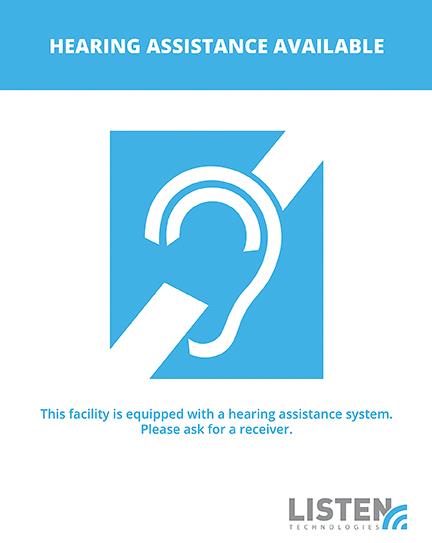
Assistive listening systems can be described as amplifiers that bring sound directly to the ear. They work by separating the sounds that a person wants to hear from background noise that may be happening around them.
These systems are used to help overcome common listening challenges by minimizing background noise, overriding poor acoustics of a room, and reducing the effect of distance between the sound source and the person listening. These situations occur more often than most people realize and can include houses of worship, convention centers, theaters, auditoriums and other large venues. Visitors can quickly become frustrated with their experience at the venue if they are unable to accurately hear the information being presented.
Today 17% of adults in America report some degree of hearing loss due to congenital loss, aging, injury, prolonged exposure to loud noise, etc. Because of this, many venues incorporate an assistive listening system not only to improve the visitor experience but to comply with the Americans with Disabilities Act. Some of the newer requirements of the ADA for assistive listening systems include:
- An assistive listening system needs to be provided in assembly areas where audible communication is integral to the use of the space.
- Assistive listening is required to be provided where there is amplified sound, such as a microphone or speakers.
- A percentage of receivers are required to be hearing-aid compatible and interface with telecoils in hearing aids.
There are additional ADA requirements and exemptions so it is important to review the full ADA requirements for your specific application before purchasing a system. In addition, there are some tax credits and tax deductions available in certain situations which may help cover the cost of the new system.
Available Technologies
Assistive listening systems utilize RF (radio), IR (infrared), or inductive loop technologies to bring audio to the listener. While they each take a different approach, all three technologies transmit the audio source wirelessly to a personal receiver or directly to a compatible hearing aid.
Radio Technology
This system delivers audio to the listener with broadcast technology along with an RF receiver and earphones. There is usually a small transmitter with an antenna that is worn by the recipient, offering them mobility and flexibility. The RF system is ideal for guiding group tours and offers great wireless coverage for large areas such as convention centers and large auditoriums.
Infrared Technology
Using infrared light, the audio is transmitted with a modulator, emitter, IR receiver and earphones. The audio signal is conveyed onto a sub-carrier in the modulator, which in turn is converted into infrared light by the emitter. This system only works in line-of-sight environments and does not go through solid surfaces. This can be beneficial in venues that require privacy, such as a courtroom. This system requires all listeners, regardless of whether or not they have hearing limitations, to wear the IR receiver.
Inductive Loop Technology
In this system, a magnetic field is used to wirelessly transmit audio to the listener. It has a wire, or flat copper tape loop installed usually on the floor of the venue. Anyone with a compatible hearing aid (one that includes a T-coil) will automatically receive the assisted listening signal when they enter the range of the coverage. Listeners without the T-coil equipped hearing device can use a receiver unit to benefit from the assistive listening system.
Regardless of the type of system selected, be sure to post visible signage at the venue and in event advertising to make people aware that the facility is equipped with a hearing assistance system.
Find a wide selection of assistive listening systems at the AV Superstore and be sure to contact our audiovisual experts with any questions regarding choosing the best assistive listening system for your venue.
